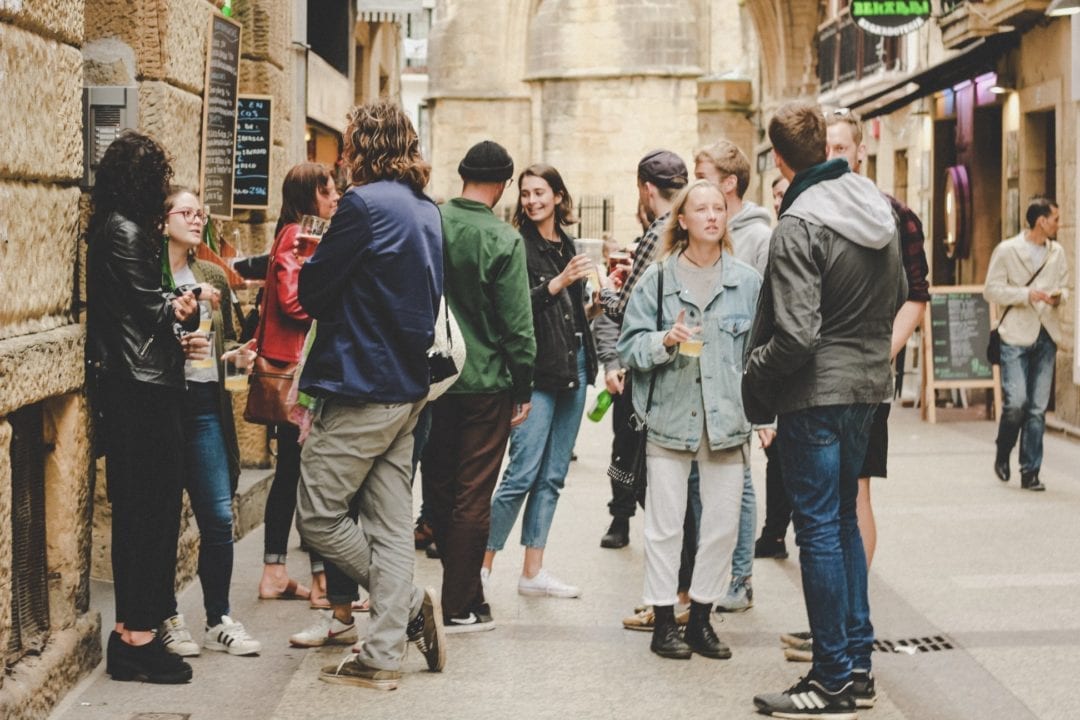San Sebastián has often been hailed as the gastronomical capital of Europe – that is until our froggy friends over in Paris nicked the title off them a couple of…
Contact Us
We’re here to help, so hit us on any of the channels below or scroll on down for the contact form.
BARCELONA BOATS Email
san sebastian surf Email
Phone
Everything Else
BARCELONA BOATS WhatsApp
SAN SEBASTIAN SURF HOUSE WhatsApp
Social
A BACKPACKER’S GUIDE TO SPAIN
Backpacking Europe » City Guides
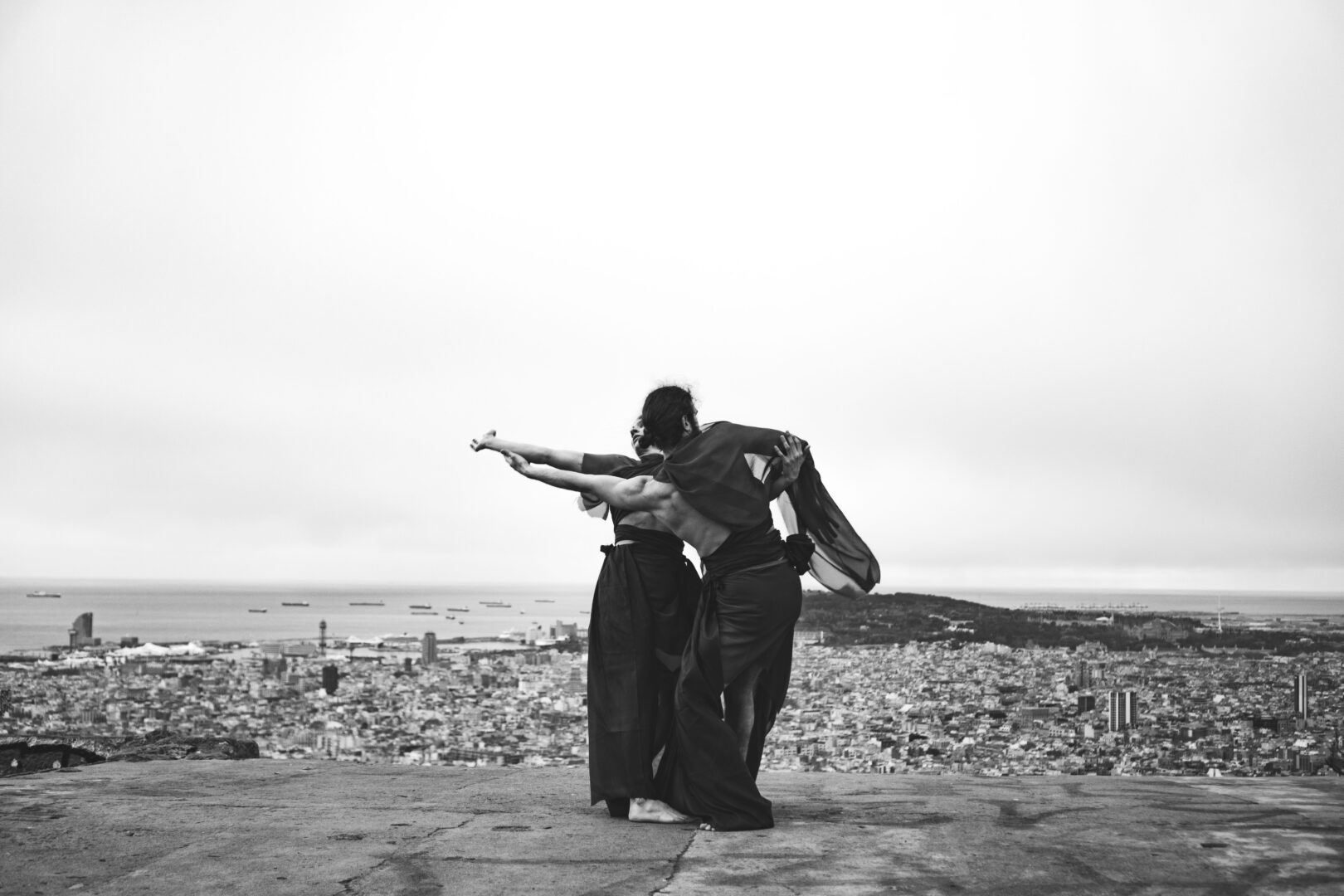
The first thing that strikes the first-time visitor to Spain is just how little it is like anything you expected. Sure, there are beaches and flamenco dancers and so, but only in some parts! And in the other parts? Other things! Mountains and deserts, ghost towns and bustling metropoli, Spain is more a collection of cultures, languages and climates than a homogenous nation. It’s this diversity that keeps you coming back, with the limits on exploring defined only by how much time you have in the country. Also, the Spanish way of life is disgustingly agreeable, a relentless mission to live, like really live, to the point of being unreliable and lazy, to enjoy the pleasures of food and drink and more food and plenty more drink, to chat loudly and incessantly with your neighbours about nothing, which is everything, to drag a plastic chair out into the street and watch the world unfurl, to nap in the middle of the day and let your kids run wild until two in the morning.
From the often-rainy northern Atlantic coast, through the deserts of the rural and mountainous interior and to the sun-soaked Mediterranean beaches of the south and east, Spain is a land of stereotypes and surprises, one where siestas are still taken, and children play in the streets at 1am, where tapas is often offered free with the purchase of a beer, a land of fabulous wines and the world’s best nightclubs, political strife and immense generosity towards strangers. Modern Spain is a Catholic country with a conservative government that has long legalised gay marriage, with an unavoidable nudist tradition on its beaches, and Spaniards are among the biggest drug consumers in Europe. The country is a forward-looking democracy with a vibrant urban life, supported by an indelible connection to the “pueblo” and the traditions passed down through village life.

Facts About Spain
Spanish Population: 47 million
Tourists to Spain in a year: 75 million
Spain’s biggest cities: Madrid, Barcelona, Valencia
Languages spoken in Spain: Spanish (Castellano), Catalan (plus variants in Valencia and Balearic Islands), Basque, Galician
Average wage in Spain: €1300
Price of things in Spain: coffee €1.50, beer €2 (50¢ supermarket), three course lunch meal with wine €10, decent bottle of wine (supermarket) €4, pack of cigarettes €5, gram of cocaine €60
Times things happen in Spain: 10am work starts, lunch 1-3pm, siesta 2-5pm, finish work 6-7pm, dinner 10pm, bars close 3am, clubs close 6am
Average summer high temperature in Spain: Barcelona 30°C, Ibiza 29°C, San Sebastián 25°C, Pamplona 28°C, Santiago de Compostela 24°C, Madrid 34°C, Seville 35°C
Average winter low temperature in Spain: Barcelona 5°C, Ibiza 8°C, San Sebastian 5°C, Pamplona 2°C, Santiago de Compostela 4°C, Madrid 4°C, Seville 7°C
Spanish Festivals
Yeah, we love to party, which is about 95% of the reason why we started Stoke Travel here in Spain, where there’s a fiesta every day of the year and even the tiniest villages have all-week ragers that would put the best parties in our big cities to shame. Here’s a little list of the best Spanish fiestas:
Sitges Carnival: Carnival is all about letting your hair down before Lent, getting all those desires out of your system before the pious repression that leads up to Easter. We don’t follow lent, but that doesn’t stop us from getting right in Carnival and where better than Sitges, the seaside resort that’s a known hotspot for hedonism and one of Europe’s gay capitals. Parades, costumes and people doing things that only anonymity allows them to do.
San Vino Wine Fight: the first of the summer Spanish fiestas, San Vino Wine Fight, la Batalla de Vino de Haro in the local language, is an all-out pitched battle where the only weapon you’re allowed to use is red wine, which is flung, shot, poured, dumped and splashed on absolutely everybody by absolutely anybody. It’s purple-soaked madness for lovers and haters of wine alike.
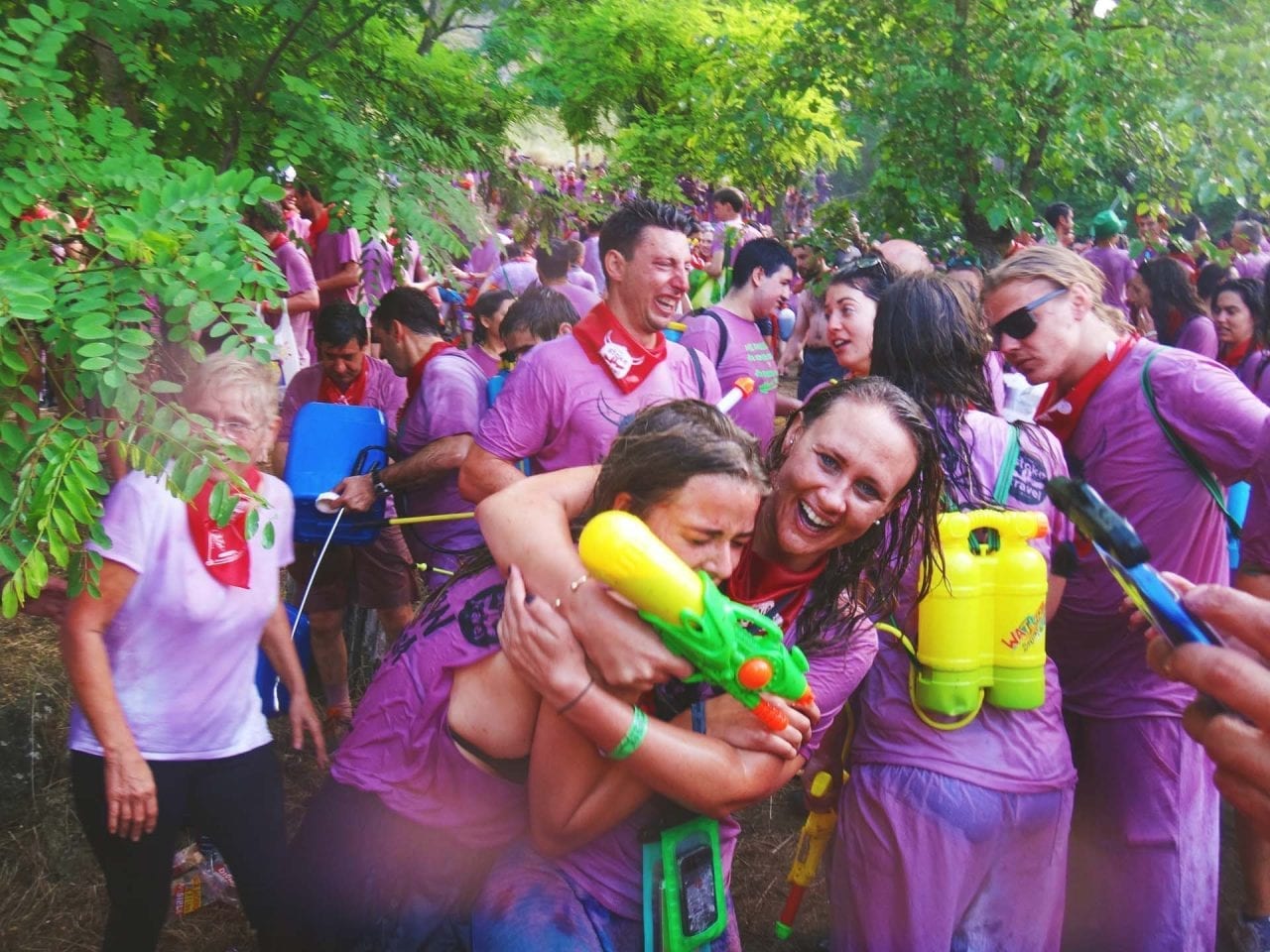
The Running Of The Bulls: Pamplona’s San Fermin fiesta, otherwise known as the Running of the Bulls, is so much more than the infamous, brave and stupid run. It’s the biggest street party in the world, hundreds of thousands of people from Pamplona, Spain and all around the world enjoying hundreds of years of tradition. The bull run takes around five minutes every morning, while the party goes for 24 hours, over eight days, plus the opening and closing ceremonies. San Fermin is by no means a party for daredevils only, it’s for party animals, culture vultures and sangria lovers alike.
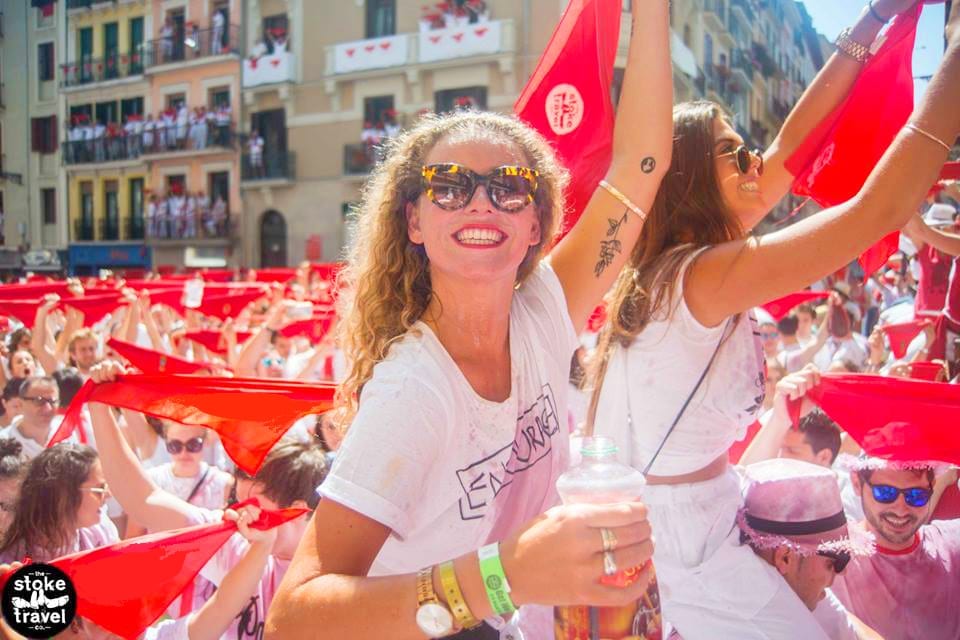
Running of the Bulls
La Tomatina: Valencia’s tomato fight is the best way to waste otherwise edible salad vegetables. The peace that you find when launching a soft tomato into a stranger’s face is cathartic, counterbalanced by the anxious excitement that comes from being a target yourself. La Tomatina is the best way to get saucy, squishy, juicy and to fill your every orifice with tomato seeds for weeks to come.

Spain Transportation
Car rental in Spain: we think this is the way to go, if hiring a car makes sense for your budget and group size. With a car you can get off the beaten track and into the unknown, you can move at your own pace and you can explore your surroundings with total freedom. The rules for car rental here are the same as they are for hiring a car in the rest of Europe, so you’ll need a valid driver’s license, an international permit and a credit card. It also helps if you’re over 25-years-old. All the big operators have a presence in Spain, as well as some budget local operators. We suggest using rentalcars.com to compare deals.
Flying in Spain: due to the almost unbelievable number of tourists who come to Spain in search of sun and sangria every year there are plenty of flights linking Spanish cities with each other and the world. Local carriers, Iberia and Vueling, as well as Easyjet, Ryanair and Norwegian, and almost all the European budget airlines, have a big presence in Spain, and prices are very competitive. That said, you’ve got to weigh up the options and decided whether flying is the best option for your Spain trip. We feel like it’s a shame flying over this diverse country, and some of the best Spanish experiences happen off the highways in the middle of nowhere. If you’re pressed for time, flying is a great option, but if time’s on your side slow it down and go overland, unless you’re going to the Canary or Balearic islands, in which case you might need to do it in a bird.
Train travel in Spain: the trains in Spain go mainly across the plain, and also in mountains, and do so at a fantastic rate – Spain has more high-speed track than anywhere in Europe and speeds get up to 300kms/h and then some. The train service can be more expensive than buses, but more comfortable and quicker, particularly on the Barcelona-Madrid route. Are you travelling to multiple countries and have considered if it’s worth getting a if it’s worth getting a Eurail pass? If you’re rushed and don’t want to take the highways, compare flight and train prices and bear in mind that trains will drop you in the centre of town. Also a good, scenic option outside the cities.
Campervan hire Spain: you can park and sleep anywhere, unless otherwise signed, so long as you aren’t “camping”. Camping means you have put out your awning, lifted up your wheels, or are running a generator. Otherwise you just have to obey regular parking rules. Many popular spots will have height-restricting gates at carparks, so make sure your car is under two meters, generally, or just park in the street. Spaniards are notorious nature defecators, so be careful walking around carpark shrubbery barefoot. Campervan companies that operate in Spain include Wicked Campers and Indie Campers, and you may want to look at hiring a campervan for your Europe trip.
Bus travel in Spain: buses run everywhere, reasonably quickly, for less cost than the train services. The main bus line in Spain is ALSA and they have a premium service with snacks, movies and wifi that could be worth splashing the extra cash on. Some routes are a far bit longer on the bus, like Barcelona to Madrid, which will take more than six hours on wheels, and three on the train. We find that buses are an integral part of your Europe trip, almost a necessary evil.
Accommodation In Spain
Couchsurfing Spain: the cheapest and also potentially the creepiest accommodation, couchsurfing is a great way to meet locals, make friends and do things on the cheap. Make sure that you keep your wits about you and apply the same common sense you’d apply to staying in a stranger’s place in your home country. If you want to work in exchange for your food, consider workaway, and it is also possible to housesit all across the country.
Sleeping in your car in Spain: as outlined in the camping car section above, it is possible to sleep anywhere in your car, so long as you’re not setting up camp in the street. Sometimes backpackers seek to avoid city hostel costs by parking in their cars in underground carparks. Just don’t get caught by the attendant and have plenty of water on hand as it can get really hot.
Camping in Spain: plenty of campsites all over Spain that you generally won’t have to book in advance. If you have a hire car it could be worth your while to stop in a Decathalon sporting goods store and purchase some gear, and go for the outdoorsy option in many of your Spanish destinations. Or just stay at one of Stoke Travel’s all-inclusive camps…
Hostels in Spain: the hostel scene is thriving in Spain as it grows as a backpackers’ destination. There is a great array in almost all destinations and you’d be smart to investigate the reviews before making your choice, because sometimes surviving a hostel stay is hard work. In rural areas hostels can be as cheap as €10 a night, for a dorm bed, going up to €30 and more for the fancier places in the cities. You’ll pay more for smaller dorm rooms, female-only dorm rooms, and more again for private rooms in hostels. In many places you’ll need to have your own towel, though bedding is generally included. Again, just check before you book and an email to the hostel before you arrive won’t hurt either. Try HostelWorld to compare prices and ratings.
Hotels in Spain: varies greatly from place to place, but for the hotspots, like Barcelona, Madrid and San Sebastian, hotels are not only expensive, but often booked out. Sometimes, however, you feel like treating yourself and enjoying a little extra privacy, We like to check Booking.com for special deals, especially when we’re outside the tourist hotspots.
Airbnb in Spain: can be a real good deal with a group of people, but is mostly illegal in some places like Barcelona. Check before you book and make sure the place is legit. You don’t want to get turfed out on the street because you booked with a dodgy operator.
Spanish Food And Drink
The line between bar and restaurant is blurred in most of Spain’s 350,000 or so eating and drinking establishments (that’s about one for every 130 Spaniards), as is the line between going for a drink, a bite to eat, or just simply socialising – in many parts of Spain they’ll serve you food for free, if you just order a drink. In Spain life happens mostly outside of the house, and at a certain time of day, or a few certain times a day, that life is transpiring in a bar.
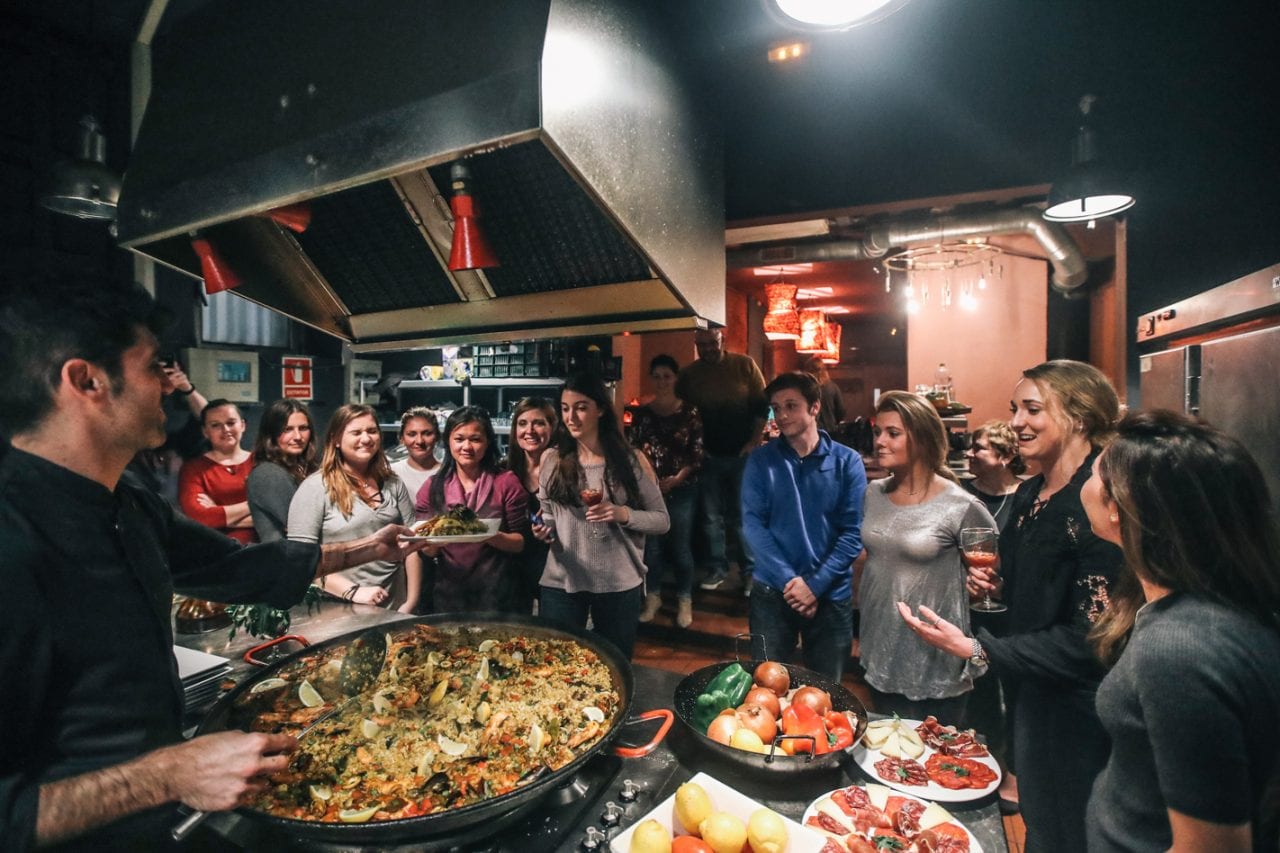
Spanish Food
The cuisine in Spain is as varied as everything else about this wonderful country, but if there’s one thing that unites the peninsular it’s that meals here are for sharing. Very rarely will groups of friends go out for dinner and eat their own plates, communal eating is key here and a wonderful way to try a larger array of Spanish treats. Plus eating in Spain is cheap! So you can try a lot of stuff and not blow the budget. One thing that backpackers have to get used to in Spain is that the daily meals and meal times look a fair bit different to what they may be used to.
Breakfast in Spain: desayuno can be as simple as a coffee and a croissant, toast with tomato, ham, cheese or marmalade, fried churros and chocolate. Depending on the establishment, you can order a more substantial breakfast, like a portion of tortilla de patata, a Spanish omelette with potato, or any number of bocadillo, or bread roll, combinations. Spaniards keep breakfast light, but they will often snack before lunch. As a backpacker it’s best to load up early and head out for the day. Take it before 10am.
Tapas in Spain: for sure you’ve heard all about Spain’s tapas culture. Now tapas might come from a menu, on top of a bar – as is the Basque pintxos culture, or for free with your drink order. Tapas time is all the time! But it also serves to fill the gap between a small breakfast and a big lunch. In Spain there is no shame in ducking into a bar every time you get peckish, and having a beer or a wine, but don’t start a drinking session. Just one with your snack and then on your way.
Lunch in Spain: la comida is the most important meal of the day in Spain, which is great news as it’s also the most pleasant and the best value for money. Wherever you travel keep your eyes peeled for bars and restaurants advertising a menu del dia, because the meal of the day will land you a starter, a main, a dessert, a drink (sometimes a whole bottle of wine) and maybe a coffee, for anywhere between €8-15. The standard varies from place to place, and you generally do get what you pay for, but if you choose somewhere that is busy with Spanish folk then you’re almost guaranteed a good meal. You will need to sit down for lunch between 1-4pm.
Afternoon snack in Spain: la merienda is a small bite that’s taken to fuel you between lunch and dinner. For kids it’s a bit of sliced meat OR cheese on some bread (Spaniards are very touchy about mixing sandwich toppings and adding condiments – for them the product reigns supreme), or a cupcake, fruit, or something else. But for adults it’s the… aperitivo, which is a delightful concept where friends will get together on a terrace and take a drink of wine or vermouth, or a small beer, and chat and snack on tapas. The aperitivo is an institution in parts of Spain where tapas is given freely, often depriving restaurants of their dinner trade…
Dinner in Spain: la cena is taken rather late in Spain, and is generally a lighter affair than lunch, considering how many plates of food have been eaten throughout the day. For backpackers, dinner is a good time to get together and try more plates, while doing a decent pre-drink for the night ahead. Dinner is served from around 9pm until midnight, and it’s very common for Spanish people to have an espresso afterwards.
Typical Spanish tapas: they vary from region to region, but there are some staples that you’ll find everywhere, like patatas bravas, fried potato wedges with spicy sauce, pimientos de padron, fried green peppers (not very spicy), jamon iberico, the famous Spanish acorn-fed ham sliced thinly, albondigas, meatballs, gazpacho, the cold tomato soup that sounds disgusting but is actually delicious, calamares, sepia a la plancha, chipirones, pulpo a la gallega, various ways to cook octopus, squid, cuttlefish, etc, gambas al ajillo, prawns in garlic, and the list goes on, and wonderfully, magnificently, on.
Main meals in Spain: what don’t they eat! Spain’s most famous dish is the paella, which is more of a regional speciality as it’s only authentic if it’s made in Valencia, with Valencian water, and with rabbit (brains included) and chicken inside, no seafood! It seems like Spanish cuisine was born from making the most out of adversity, and so we see lots of plates featuring animals, and parts of animals, we wouldn’t expect at home. In addition to beef, chicken and lamb, Spaniards eat a lot of pork, and not just the meat, but the insides, the outsides, the blood, the whole lot. They also eat plenty of rabbit and duck, hunting meats, and almost everything in the sea. Because they are so ravenous when it comes to eating animals, make sure you double check what you’ve ordered – many a backpacker’s meal has been ruined by the discovery that they’ve accidentally ordered pig’s foot, or some such. The use of pork and ham is so ubiquitous that many places unaccustomed to tourists or vegetarians will include pig products in their vegetarian options (note: a vegetable sandwich always includes tuna for some reason). The deserts are often heavy on milk and eggs, like flan and arroz con leche, crema catalana and pudding. All in all, the food is good, hearty food, that’s not overly spiced (or spiced enough) and often fried. Considering that much of Spain is on the Mediterranean, one wouldn’t assume that the diet is healthy given the plethora of fried foods, but the basics are there for the Med diet, like plenty of seafood, good olive oil and fresh fruit and vegetables.
Vegetarian eating in Spain: you won’t find it as easy as you would at home. In the big cities there are vegetarian restaurants, but outside of these strict vegetarians and vegans would find it difficult to be assured that plates haven’t been contaminated with animal products. In the countryside you’d be doing well to find even a salad without ham or tuna in it, and the serving staff might not understand what you mean when you say you don’t eat meat. That said, there are ways to stick to your vegetarian or vegan diet in Spain, most of which mean taking advantage of the great and cheap fresh produce available in the markets you’ll find in every village and city.
Spanish Drinks
Ok, first and foremost you absolutely can drink the tapwater in Spain. In some places it tastes gross, like Barcelona, but others, like San Sebastian, it’s utterly delicious. If tap water isn’t your deal, then perhaps try a Vichy Catalan sparkling water, because they are amazing. Juices are called zumos and most cafes and bars will have a machine that freshly squeezes oranges. In Valencia they have a weird milk drink called horchata that you should probably try, but that isn’t too impressive.
Spanish beers: But enough about that, let’s talk about the good stuff. There are plenty of Spanish beers, but the best one is Estrella Galicia, followed by Estrella Damm, Mahou, San Miguel, and on and on. Spanish beer sizes start with cañas, which are good to throw down fast on a hot day (don’t expect them to fill the glass, that’s just not how they pour beers). Up from a caña you can order a copa, which is a bit bigger, or a pinta, basically a pint, and a jarra which is a jar, or sometimes jug. Look at what the other patrons are going for and follow suit. You can also order your beers by the botella, or on hot days botellin, which is a small version of the beer bottle.
Spanish red wines: we could write about Spanish wines for years without scratching the surface. Spain is most famous for its red wines, which come from many regions across the country, the best being La Rioja, Ribera del Duero and the Catalan reds, Priorat and Montsant, made mostly from tempranillo grapes as well as some garnacha as well as blends. Spanish red wines will be sorted according to region, not grape type, and are organised according to how long they’ve been in cellar maturing. Joven wines are usually from the year you’re purchasing them, crianza wines have spent at least six months in the oak barrel and another 18 months in the bottle, reservas are required to rest one year in oak and another two in the bottle, and gran reservas must be aged for five years in total, two of which will be in the barrel. Unless you’re a real connoisseur a joven wine will be delicious and a crianza will blow you away. Reservas and gran reservas tend to be too smokey for immature palates. As far as price is concerned, you can drink a €2 bottle, really enjoy a €4 bottle and impress the pants off somebody with €7 bottle and above.
Spanish white wines: not as world renowned as the reds, but still great on a hot, summer’s day, sitting outside, with friends, seafood and perhaps a little ham and cheese platter. Sounds lovely? Well the wine really is. The best Spanish white wines come from a few different regions, Rias Baixas and Rueda among the best of them, and the grape varieties to look out for are albarriño and verdejo. We also love txakoli, the tart, lightly fizzed white wine made only in the Basque Country, that is especially lovely with a pile of mussels.
Spanish mixed wines: many a backpacker comes to Spain looking for sangria, and fair enough, it’s the red-wine mix that Spain is most famous for, around the world. We would sugest, however, that you insist on sangria that is casera, or made on the premises, because this means that they’re actually trying to serve you something tasty. Instead of sangria, we usually go for a tinto de verano, which is a low-quality red wine mixed with gaseosa, which is sparkling, light lemonade. Generally when we’re sitting down for a menu del dia and the waiter brings out a bottle of table wine it’s not rude to ask for some gaseosa to turn an ok wine into a refreshing summer’s treat.
Stronger Spanish drinks: there’s a thriving gin culture in the Balearic Islands, particularly Menorca where they mix it with lemon soft drink and freeze it to the point of slush and call it a pomada. Fortified wines like jerez (sherry) come from the area around Jerez in Andalucia. Many regions make their own liquors with various hierbas, but the patxaran from Navarra and Basque Country is the most unique, made with berries found on the slopes of the Pyrenees. You can drink these anytime, but taken after dinner it’s supposed to act as a digestive, but probably just makes your walk home from the restaurant more pleasant.
General Spain Advice
Scams and dangers in Spain: there are a few scams that backpackers need to be wary of in Spain. Primarily, the biggest cities are rife with petty crime and pickpocketing. Be sure to employ all the general pickpocketing precautions when venturing into the bigger cities, be on the lookout for dodgy new “friends” and be wary of situations where your bodyspace is compromised or strangers can get their hands on you. The basic pickpocketing technique is distraction, whether by touching you, or occupying your attention. The threat in Spain isn’t any higher than elsewhere in Europe, and you can apply any of the general techniques to avoid pickpockets and petty thieves.
Terrorism in Spain: while the threat of domestic terrorism from the Basque separatist group ETA has gone away since their ceasefire, the August 2017 attacks in Barcelona and Cambrils, and the Atocha train station bombing of 2004 indicate that Spain can be a target of terrorism, however infrequent. The threat is low, and there’s really not much you can do to avoid it, apart from not going towards the action if you see multiple police cars and ambulances rushing somewhere.
Driving in Spain: there is so much to see and do along the many highways, national roads and country tracks all through Spain that one could spend a lifetime driving around the peninsular and not run out of exciting new adventures. Some roads come with high tolls, around Barcelona for example, but opting out of the toll roads and onto the national carriageways is a great way to explore Spain off-the-beaten-track. To drive in Spain, just like elsewhere in Europe, you’ll need a valid license and also an international drivers’ permit (not necessary, but also doesn’t hurt). The speed limit is 120km/h on highways and they drive on the right-hand side of the road. Petrol is cheaper than other Western European countries, but more expensive than Eastern Europe. Spanish drivers are terrible at cutting you off and for a country seemingly happy to often run late, they’re always in a rush on the roads.
Best way to access and use money in Spain: use your credit or debit card almost everywhere in Spain. Where unavailable in restaurants, bars and stores, the staff will direct you towards the nearest ATM. If a taxi driver in a big city suggests that card payment is unavailable press them, as they may prefer cash to avoid paying tax. There are some reports of card skimming, so make sure you check the machine for tampering before use (dodgy card slot, loose keypad, etc). In our experience the best bank to use for withdrawals is Sabadell, as they seem to charge no fees, as do BBVA and Banco Popular. Your bank at home might charge a fee, and finding the best way to access money overseas is something you should sort out before you leave home.
Mobile plans in Spain: if Spain is the first destination of your overseas trip it would be wise to pick up a mobile plan with data there, as European Union rules now mean that you will not be charged extra when roaming from country to country. As a backpacker, you will not be getting on a phone contract in Spain, but you will find some great pre-paid options that come with data. Just make sure you can top up your plan online, so you can do it wherever you are travelling without worrying too much about the language barrier. The big carriers in Spain are Movistar, Orange and Vodafone, with Yoigo and Lebara offering competitive deals for travellers. Do be wary of dodgy operators selling you used, or limited sim cards.
Visa options for Spain and how to stay longer than the allocated three months: so Spain is a part of the Schengen zone, which means you’re allowed to stay in Spain, and other EU countries, for 90 days out of every 180 days without a visa. Three months! Not enough to see the delights of the Iberian peninsula, let alone properly explore the rest of Europe. Well, never fear, as to stay in Spain for longer than 90 days you have a few options. First, and easiest, is a student visa, which are offered to people studying in Spain, even when studying certain courses at Spanish language schools. These are valid for up to a year. Also available for a year is the working holiday visa, which is only offered to backpackers from certain countries, and allow you to work a little and travel a lot for a year in Spain.If you’re really committed to staying in Spain, there are long term and permanent visas available to people who are offered employment, or who have money to invest in the country.
Places to visit in Spain
Oh the things you can see and do across Spain, from the Pyrenees mountains that run west to east along the northern, French border, the Atlantic coast going west to Galicia through Basque Country, Cantabria and Asturias, all the while presided over by the impressive Pico de Europa mountain range, the historical interior of Castile and Leon, the winemaking region of La Rioja, Catalunya and Valencia’s Mediterranean coastline, Andalucia that literally looks over to North Africa, ancient Aragon, wild Navarra, the mountains and deserts of Extremadura, the Canary Islands off the coast of Morocco and the Balearic Islands in the Mediterranean – there’s too much to see and do in Spain in just one trip. You’ve got to come back and back again just to scratch the surface. Nevertheless, here are the hottest spots.
Madrid: the centre, the capital, smackbang in the middle of the country, home to the king and three hours from anywhere in the country, more or less. Madrid is where you can simultaneously get a taste of every Spanish province, as well as a uniquely madrileno way of doing things. Hot in summer, cold in winter, not much in between, come here for authentic Spanish food (tapas come free with drinks), all the hedonistic excess you’d expect from the capital, and enough monuments and castles to fill your Aunt June’s memory cards.
Barcelona: ok so now take everything that Madrid has, but make it a little… different, a little quirkier, less regal. Add a bit of grime and put it by the sea, and you’ve got Barcelona, an absolute favourite for tourists, Stoke Travel’s home, and a place where petty crime and high art rub shoulders along the shores of the Mediterranean Sea. Barcelona is a playground for backpackers, with art and architecture, good times and challenges around every corner. What was once a sleazy port city is still a sleazy port city, only now with more expensive hotels. There’s no such thing as an Iberian itinerary without the Catalan capital.
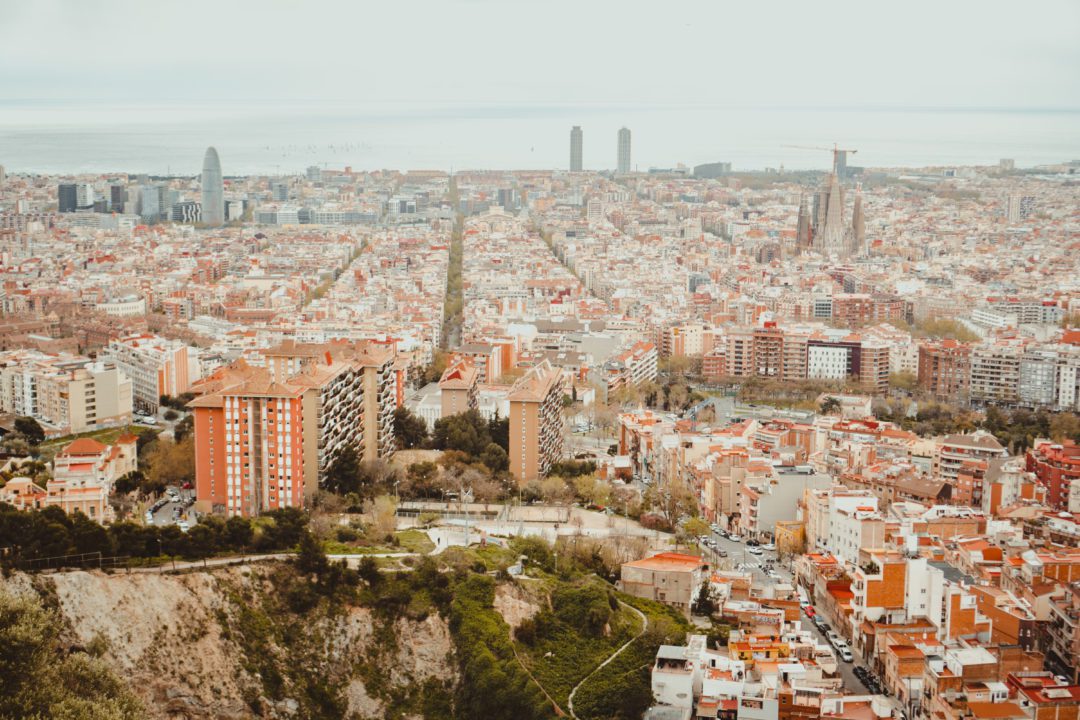
Valencia: smaller than Barcelona, but with better weather (which is difficult to comprehend), Valencia is famous for its oranges, its tomato fight, and the week when they set fire to everything. Located south along the Mediterranean coast from Barcelona, think year-round sun, late-night clubbing and lot of paella in Valencia, the most famous of Spanish dish’s home.
Ibiza: the most famous of the Balearic Islands, this one-time hippie haven is now home to the rich, famous and fucked up. Ibiza is known for its clubs and nightlife, but not far from that drug-soaked strip you’ll find pristine beaches, farmland and amazing Mediterranean cuisine. And more drugs, probably.
San Sebastian: the beauty of the Basque Country, this Atlantic-side holiday town sits up close to the French border and retains a little elegance perhaps related to its location, that’s until you slip slightly underneath its skin and find a gritty surf town dressed up as a snobby city. Bars galore, more than anywhere, per square metre, and some of the best food in the world. Come for the waves, stay for the pintxos, and never stop coming back, that’s the San Sebastian way. Want to come to San Sebastian and learn how to surf? Our Surf House is the place.
